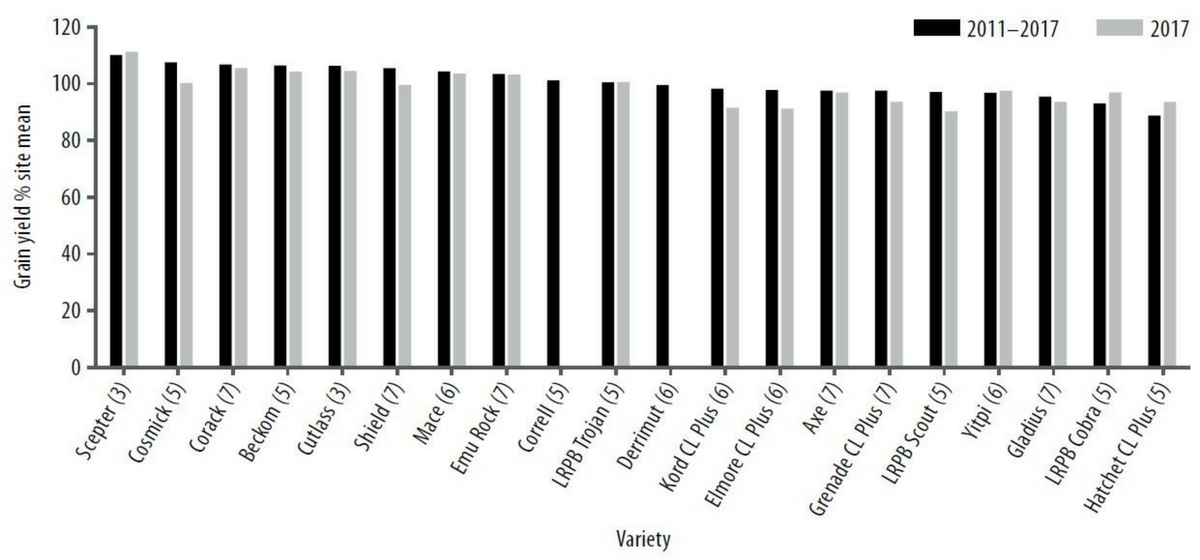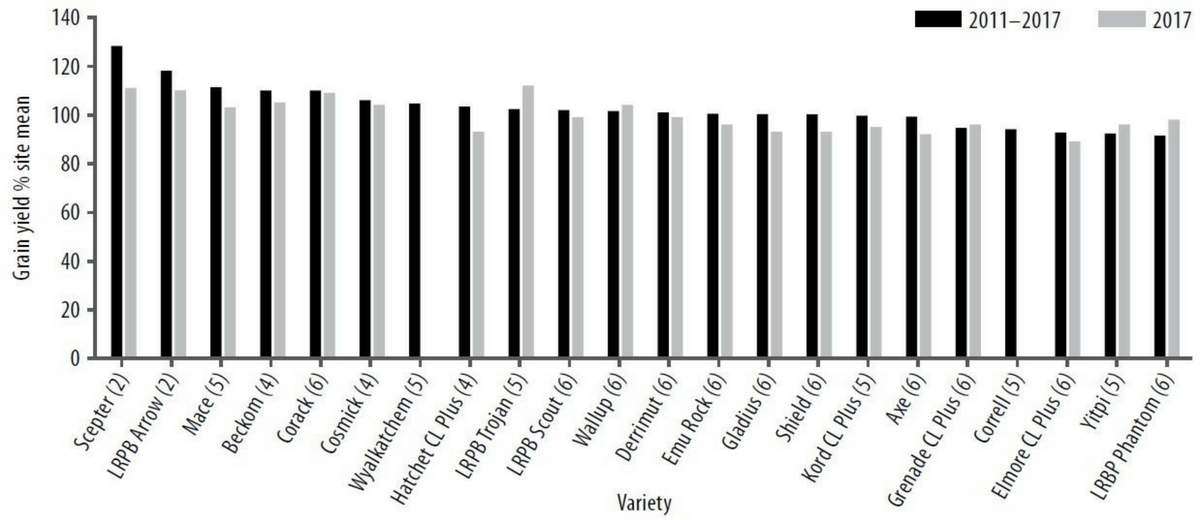Take home messages
- Scepter, LRPB Trojan, Corack and Beckom were the highest yielding varieties in the Mallee in 2017.
- Scepter can now rightfully be considered a very suitable and favoured variety for the Mallee.
- Consider new varieties such as Longsword for earlier sowing options in years to come.
Background
On the back of the high yielding 2016 harvest, cereal crops were unpopular with growers principally due to their low grain prices at the time. An increase in global demand for pulses meant their prices were high, as well high levels of enthusiasm towards growing the nitrogen (N) fixing crops. Consequently, the area sown to pulses in the Wimmera and Mallee increased significantly in 2017, and the area sown to cereals was slightly lower.
Despite all of this, good soil moisture levels during the 2017 summer, a perfect break in April, good start of the season and the continued hope that prices would increase, meant for that wheat paddocks were sown into moisture.
The Mallee experienced similar to long-term average rainfall, while the Wimmera was about 25mm above long-term average for the growing season. However, winter was dry with June having very little rainfall, and August rains helped crops enormously though spring. Frost, mice and Russian wheat aphid were the biggest hurdles many faced in 2017.
Aim
To summarise the wheat variety data released by GRDC-funded national variety trials (NVT) between 2011 and 2017 for the Mallee and Wimmera regions.
Method
The analyses for this summary was carried out using the NVT data sourced from the website (www.nvtonline.com.au). Grain yield data is represented as a per cent of the site mean which shows how the variety performed in a given season compared to the sites overall mean yield. The data has also been grouped into three regions: North West Mallee, North East Mallee and Southern Mallee to investigate the impact of environmental and soil type factors. Varieties used for this analysis were only included if they had been in the NVT for three years or more.
In 2017, sites were sown at Manangatang and Quambatook on 2 May, Birchip on 5 May, Hopetoun and Ultima on 9 May, Merrinee on 11 May and Walpeup on 12 May. The Wimmera sites were sown at Brim on 10 May and Kaniva on 12 May.
Pests, weeds and diseases were controlled according to best practice management.
Results and interpretation
The Mallee NVT sites were all sown into adequate soil moisture and consequently emerged shortly after sowing.
Unlike previous years where there was a clear trend in terms of a particular maturity group yielding well; this year, the top four yielding varieties were spread amongst an early-mid, mid, mid-late and an early-mid respectively (Figure 1). This is potentially a reflection on the 2017 seasonal conditions.
Several severe frost events in winter and later in spring affected wheat regionally, much more than normal. Damage from frost is not always an issue on all soil types and elevations, rather it can be isolated to specific low-lying areas and also crops at the most susceptible stages. This is important when comparing varieties commercially (in-paddock) and in small plot trials. This is one benefit of NVT as they can be a reference point to determine if what is happening commercially is the same as what is happening in trials throughout the region. Essentially, be careful not to throw the baby out with the bath water!
There were commercial/farmer situations where seeding rates differed to what was planned due to the 2016 large seeds that were harvested. To counteract this, you either need nutrition up-front or increase the seeding density. Both of these options are less popular for growers as it means they need to fill up more often. However, an article also written in this publication ‘Seed size, sowing rate and phosphorus in barley: Do your sums before you sow’, pp. 150, proves why calculating and calibrating seed and/or fertiliser is worth the time investment!
During winter, crop growth appeared slow potentially due to a dry period, in particular June which meant limited opportunities for N topdressing. With low N soils due to a high yielding 2016, more up-front N or phosphorus (P) may have assisted with early growth. Situations where N was applied upfront and/or at sowing (northern Mallee) did a lot better as the crops had adequate nutrition early on, provided they didn’t then get hit by the frost later in the season
Mallee results
Across the trials in 2017, Scepter and Beckom were the highest yielding varieties in the North East Mallee, which is well supported and consistent with previous seasons. It should be noted however, that Scepter has only been in the NVT since 2015 (Figure 1), possibly indicating a slightly better potential than those that have been included for more than five years. Scepter is essentially the ‘Mace/Corack’ replacement which is ideal for wheat-on-wheat situations but with slightly less susceptibility to stripe rust than Mace. Scepter, Corack and Mace all yielded higher in 2017 than their long-term average would suggest.

In the North West Mallee, Scepter, Cosmick, Corack, Beckom, Cutlass, Shield, Mace, Emu Rock and Correll performed equal to, or better than the site mean (Figure 2). Correll was not included in NVT in 2017.
The new variety Longsword was not in the main season NVT trials but featured in the NVT early break trial at Hopetoun, and also in the GRDC-funded ‘Managing early sown wheat’ project, for results see pp. 88.

Scepter was closely watched throughout the season, flowering on 25 September at the Birchip NVT site, approximately the middle of all varieties. Hatchet CL Plus and Axe both flowered on 15 September; the first varieties to flower at the Birchip site. This did not appear to lead to a yield trend, despite the frosts. LRPB Trojan, Corack, Cutlass and Kord CL Plus all performed better than their long-term averages would suggest (Figure 3). So, it is hard to attribute a specific reason for their differences.

Wimmera results
In the Wimmera, Scepter, LRPB Arrow, Mace, Beckom and Corack have yielded higher than the site mean over the past seven years, although not all varieties were trialled every year (Figure 4). In 2017, LRPB Trojan performed really well, perhaps due to its later maturity in a frost prone year. The 2017 data set for LRPB Trojan below is only representing Kaniva.

The table below shows the top six yielding varieties for each of the three Mallee regions. Scepter and LRPB Trojan are in the top six in the North East and the southern Mallee regions (Table 1). Beckom was the second highest yielding in the North East and southern Mallee. Also note that most of these varieties have only been in the NVT for three years (with the exception of Corack). LRPB Trojan, a midlate maturing variety is possibly not as well suited to the North West Mallee as it was not in the top six over the last few years. In addition, it is a longer maturing variety that is better suited to earlier sowing.
Table 1. The six highest yielding varieties from 2011–2017 for each of the Mallee regions with grain yield shown as a per cent of site mean.
When looking at the regional long-term data, LRPB Trojan, Beckom and Cosmick still performed reasonably well and were in the top five yielding varieties. This shows the importance of looking at variety performance over a longer time frame.
Commercial Practice
NVT are principally conducted to identify the varieties that have a greater yield potential under the same growing conditions. In a commercial world, the stars don’t always align so in order to achieve these yield advantages growers need to ensure they are getting everything right first such as the agronomy seeding equipment and timeliness. Early nutrition is important to adequately promote vigour and tillering, especially on sandy soils, so roots can access moisture at depth later in the season.
Varieties perform differently depending on the region and season. The 2017 season was favourable with a good break but a dry June and July, and recovering rainfall in August. It was also plagued with a higher number of frosts in winter and spring. There are a lot of new varieties to choose from in the Wimmera and Mallee, providing growers a large selection to best suit their own farming system.
When deciding which variety to grow, consider all aspects of the farming business. Farms of larger size may need to look for a shorter season variety to sow later, or a longer maturing one such as Longsword to sow dry. Also considera Clearfield variety, weed competition, nutrition and pest and disease control. If you decide to change varieties understand how it performs over several different seasons. Discuss changing varieties with your agronomist before making any decisions, remember yield is king but the accompanying agronomic package is equally as important.
The new Clearfield® wheat (with Mace parentage) that is soon to be released will be exciting. However, in the meantime if you are looking for a Clearfield variety, select from Kord CL Plus or Grenade CL Plus as they are currently the best in the market.
When growing a new variety, the most important practice is to ensure the agronomic aspects are right; the yield advantages will not be realised unless the agronomy is sound!
References
Victorian Winter Crop Summary 2017, Agriculture Victoria.
Acknowledgements
The NVT were funded by the GRDC ‘National variety trials’ project (BWD00029) with analysis supported by Agriculture Victoria through the ‘Improving practices and adoption through strengthening D & E capability and delivery in the southern region (RRA)’ program (DAV00143) GRDC DEDJTR Bilateral Research Agreement.

